#宋代
Explore tagged Tumblr posts
Text
《春宵》- 苏轼
A translation with pinyin of Su Shi's 春宵 Spring Night poem.
chūn xiāo – sū shì (宋 – sòng) 春宵一刻值千金, 华有清香月有阴。 歌管楼台声细细, 秋千院落夜沉沉。 PINYIN: Chūn xiāo yí kè zhí qiān jīn, Huá yǒu qīng xiāng yuè yǒu yīn. Gē guǎn lóu tái shēng xìxì, Qiū qiān yuàn luò yè chén chén. ENG: In a spring night, a short time is worth gold and riches, Flowers emit a sweet fragrance as the moon clouds over. In the high buildings, the sounds of music are soft, And the courtyard with the…
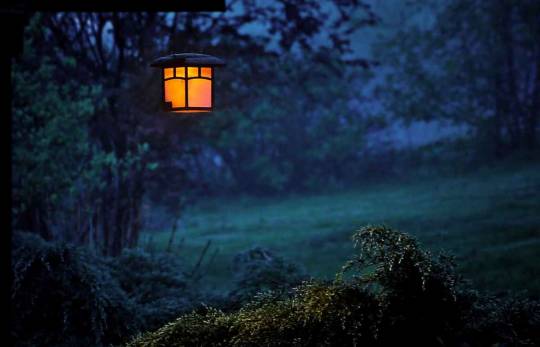
View On WordPress
#chinese poem#chinese poetry#苏轼#诗词#诗歌#learn chinese poetry#night poetry#poems about spring#poetry#song dynasty#spring night#spring poetry#su shi#su shi poems#宋#宋诗#宋朝#宋代
4 notes
·
View notes
Text
Different brow shapes in historic China. Which one do you like most?
(My favourite is the Moon curved brows and the Moth brows, although the Osmanthus leaf brow is what I picture when I think of the Tang Dynasty.)
Src:
杨子古典美学妆造
【来看看古代都有什么眉形?】
https://www.bilibili.com/video/BV1QCCJY4E2U/
(ENG subs by me :D)
#hanfu#汉服#china#中国#chinese hanfu#culture#history#古代眉毛#唐朝#宋朝#汉代#Eyebrows#Chinese historic eyebrows#tang dynasty#song dynasty#han dynasty#makeup#Historic makeup
3K notes
·
View notes
Text
[Hanfu · 漢服]Chinese Song Dynasty (960–1279 AD)Traditional Clothing Hanfu Reference to Song Dynasty Murals





【Historical Artifacts Reference 】:
▶️China Song Dynasty Mural:
《韩城盘乐村宋代壁画墓M218/China Song Dynasty Mural Tomb M218 in Panle Village, Hancheng》





Tomb excavated in 2009, the murals contain rare contents such as medicine, drama, and Buddha's nirvana. The tomb was built with fine craftsmanship using the method of grinding bricks and joints, and the murals were directly painted on the flat brick wall. According to the content of the murals, the tomb owner may have had medical experience in his lifetime, or was a local medical officer, or the owner of a medicine workshop.
______________________
🧚🏻♀️Recreation Work/Model: @闻靖
🔗Xiaohongshu App: http://xhslink.com/a/0GBTNXv6XYT1
______________________
#chinese hanfu#Song Dynasty (960–1279 AD)#hanfu#hanfu accessories#hanfu_challenge#china#chinese traditional clothing#chinese#chinese style#中華風#汉服#漢服#韩城盘乐村宋代壁画墓M218
194 notes
·
View notes
Text
南宋第一歷史謎團,女真鐵騎縱橫15年因何慘敗?史無前例的君臣博弈,以步克騎的經典戰例 《漫聊兩宋煙雲》第19集
宋高宗趙構為什麼膝蓋這麼軟,皇帝當的這麼窩囊? 金人在馬踏中原15年以後,10萬大軍,在一座小城因何遭遇慘敗? 《漫聊兩宋煙雲》的第19集,我們來聊聊宋金順昌之戰的來龍去脈。
youtube
1 note
·
View note
Text
中國試圖利用網絡和新興科技重塑國際秩序
美官員:中國試圖利用網絡和新興科技重塑國際秩序 本週二,有白宮官員公開警告說,中國正尋求透過網絡和新興技術等關鍵領域的領先,推動北京重塑國際秩序的議程。 隨着網絡和新興科技在美中戰略競爭格局中日益發揮關鍵作用,兩國積極尋求在計算機網絡、半導體、關鍵基礎設施和人工智能等領域中保持競爭優勢。 在華盛頓智庫哈德遜研究所(Hudson Institute)本週二(7月16日)舉行的研討會上,美國國家安全委員會東亞和太平洋網絡政策主任伊斯利·宋(Israel…
0 notes
Text
A fairly good general reference video about historical/traditional fashion of various cultures and peoples (including hanfu, but not just hanfu) that have been part of Chinese history:
youtube
The video is arranged in chronological order, below are the timestamps:
0:24 - Warring States period/战国 hanfu (for those who don't know: hanfu/汉服 is the historical and traditional outfits of Han people/汉族)
1:16 - Western Han dynasty/西汉 hanfu
2:11 - Jingjue Kingdom/精绝 and Loulan Kingdom/楼兰 historical outfits
2:45 - Eastern Han dynasty/东汉 to Three Kingdoms period/三国 hanfu
3:51 - Northern Dynasties/北朝 Xianbei/鲜卑 historical outfits
4:46 - Southern Dynasties/南朝 hanfu
5:25 - Sui dynasty/隋 hanfu
5:56 - Tang dynasty/唐 hanfu
6:38 - Sogdian/粟特 historical outfits
6:59 - Tubo Empire/吐蕃 Tibetan/藏族 historical outfits
7:38 - Huihu/回鹘 historical outfits (Qocho Huihu Kingdom/高昌回鹘 and Ganzhou Huihu Kingdom/甘州回鹘; note: Huihu people are the ancestors of the modern Uyghur people/维吾尔族)
8:21 - Nanzhao Kingdom/南诏 historical outfits (of the ancestors of the modern Yi people/彝族 and Bai people/白族)
9:07 - Five Dynasties/五代 hanfu
9:57 - Northern Song dynasty/北宋 hanfu
10:38 - Liao dynasty/辽 Khitan/契丹 historical outfits
11:21 - Jin dynasty/金 Jurchen/女真 historical outfits
12:07 - Western Xia/西夏 Tangut/党项 historical outfits
12:37 - Dali Kingdom/大理 historical outfits (of the ancestors of the modern Bai people/白族)
13:20 - Southern Song dynasty/南宋 hanfu
14:00 - Yuan dynasty/元 Mongolian/蒙古族 historical outfits
14:58 - Yuan dynasty women's hanfu
15:24 - Ming dynasty/明 hanfu
16:24 - Qing dynasty/清 Manchu/满族 traditional outfits
16:59 - Qing dynasty Han women's outfit
**Note: as mentioned by the OP, due to the lack of suriviving physical artifacts for some time periods/cultures/kingdoms/dynasties, there is a certain amount of speculation in this video based on other artifacts/records like wall murals, paintings, figurines, and historical records.
975 notes
·
View notes
Text
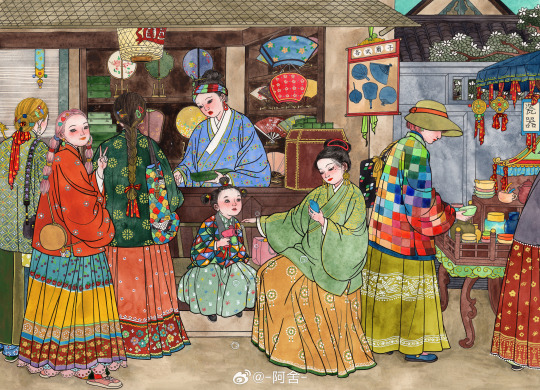
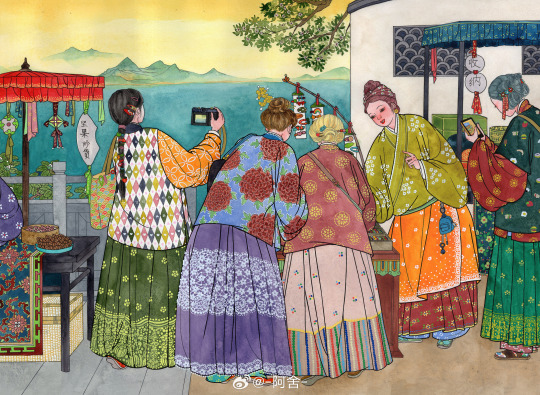

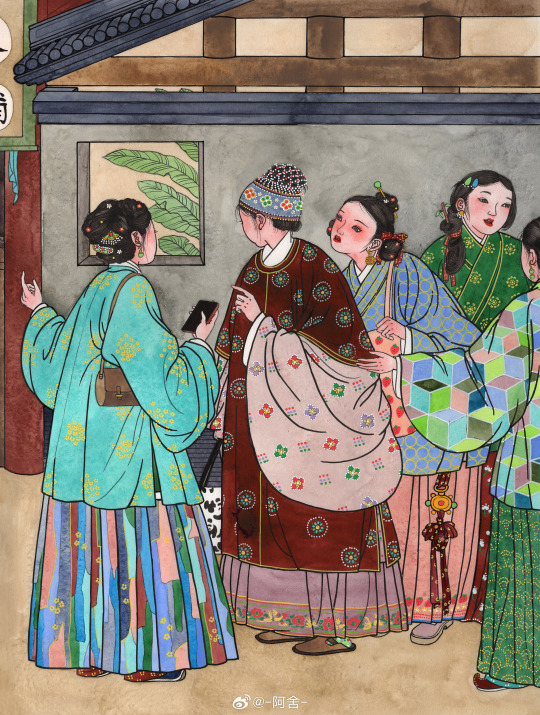
一组汉洋折衷,画背景的时候想到,那么多仿古商业街的能不能搞个带npc的沉浸式朝代体验啊。像杭州这里的南宋御街宋城什么的,围一块出来还可以和别的景点还有本地民间故事联动一下。 比如说在严官巷打卡扫码可以获得【帮吃湖蟹拉肚子的皇上找到严大夫】的剧情:扫码后获得线索到商业街找到正在四处寻医的太监,触发对话后开始找严大夫,可以跟摊贩路人对话获取地点,完成后可以获得旅游纪念胸针/冰箱贴之类的小礼物。 还有岳王庙打卡可以获得【协助狱卒隗顺运送岳将军遗体逃离临安府】?然后雷峰塔的白蛇传剧情?六和塔有水浒传剧情? 哎,想玩,我就想想 …[允悲]
A set of "Han-Yang zhezhong" [...] by -阿舍-. Han-Yang zhezhong is a fashion trend that refers to using western/European accessories when wearing hanfu. All the women in the figures were wearing Ming-style hanfu with various non-Chinese traditional elements such as shoes, handbags, belts etc.
#-阿舍-#hanfu#chinese art#traditional painting#traditional art#it was painted on pen and paper#click the link for more details#mamianqun#gongxie#yuanling#jiaoling#shuling#with permission
282 notes
·
View notes
Text


One of the first Hanfu outfits I bought was this style (I still have it). At the time I thought it was representative of the Tang Dynasty, but later found out that it's more likely a style from the Five Dynasties (right after the Tang Dynasty). Some historians have also speculated that the one large flower on the top of the head is more of a Song Dynasty style rather than Tang.
It's a good reminder that all of these speculations about historical styles are based on what we can actually dig up, but obviously tombs are limited. Maybe tomorrow we'll find a new tomb with new artefacts that'll throw everything we think today upside-down xD




#hanfu#汉服#china#中国#chinese hanfu#culture#history#fashion#clothing#historical clothing#唐朝#五代#宋朝#tang dynasty#five dynasties#song dynasty#晚唐#late tang
377 notes
·
View notes
Text


恭賀新禧 gōng hè xīn xǐ
(Best wishes for a happy new year!)
《元日》 王安石/北宋詩人
爆竹聲中一歲除, 春風送暖入屠蘇, 千門萬戶曈曈日, 總把新桃換舊符。
【元日】:指春節,即是農曆正月初一。
【爆竹】:以火燃竹時所發出的爆裂聲,古人用以驅邪避鬼,後人則以鞭炮代替。
【一歲除】:一年已經過去。除:去除,過去。
【屠蘇】:酒名。古代習俗,在大年初一的時候,全家一起飲用由屠蘇草所浸泡的美酒,用以驅邪避瘟,並祈求能夠長壽。
【曈曈】:天亮時由暗轉明的樣子。
【桃】:桃符,即春聯。古代相傳有神荼、鬱壘二神,能夠捉取百鬼,因此新年的時候,在門旁設兩塊桃木板,上面書寫二神的名稱或畫上圖像,用以驅鬼避邪。
📌 王安石(1021-1086),北宋詩人,著名的改革派政治家。他的前期詩作,以反映政治、歷史以及社會現實為主。詩中多含哲理,喜用典故。晚年退居金陵之後,轉向描寫閒適生活,詩風追求清新淡雅。
這首詩描寫了宋代人過春節的場面:春風送暖,旭日初升,家家戶戶點燃爆竹,闔家喝著屠蘇酒,忙著摘下門上的舊桃符,換上貼有門神的新桃符。作者擇取了這些過年時最典型的喜慶場景,展現了一幅富有濃厚生活氣息的民間風俗畫卷。宋人特別喜歡通過詩歌來表達自己的政治抱負、哲學觀點。王安石此是身為宰相,正在大刀闊斧地進行改革。所以這首詩的字裏行間都洋溢著他對革除時弊、推行新法的堅定信念及樂觀情緒。抒發了他春風得意躊躇滿志的心情。
53 notes
·
View notes
Text
Link Click Musical Masterlist 🔍🌟
#音乐剧时光代理人# <- 'Time Agents Musical' main tag, pictures tab - shows majority of stage pictures in chronological order, updates from official Encore Musicals show up here too.
Tips: 1) Visit the OP's profiles! They usually post more than the one photo you can see in a thumbnail. And it's easier to browse & save pics through the profile.
2) Even though you can scroll the pics tab indefinitely, without a weibo account you won't be able to easily access older posts, as they'll get buried under the user's newer posts (there's a roundabout way mentioned in my guide). So I recommend to visit this tag frequently, if you wanna be sure nothing is hidden away 🔍 Daily or once in a 2-3 days will be enough imo, it's not very crowded tag ^^
3) Video tab under main musical tag is no longer accessible due to a weibo update. For videos you can check videos tab under the individual actors' tag. You can scroll these indefinitely.
接着奏乐接着舞Musicals (Encore Musicals) <- official profile of a theatre that runs LC stage, they post the cast schedules, photos/behind the scenes clips, whenever new actor debuts, there's a special guests or a cast member has a birthday. They also report when an actor goes on a health break. Tip: all LC actors can be found in the pinned post (you'd need OCR 'image-text' tool to copy their names from pics though)
Encore Musicals Bilibili account <- theatre's official profile on a major cn video-sharing platform (more bts clips)
校医来啦 <- profile of a chief producer of LC Musical, Chen Xiaoyi
兮兮兮辞_ <- profile of an executive producer of LC musical
Metablue赛博蓝 <- bilibili of a music producer, she did videos about working on LC musical songs
🌟Actors
✨cast visuals promotional photos here✨
their personal weibo profile & actor specific hashtag (supertopic aka 'diamond tag', you find the most stuff here)
actors who graduated from the cast and no longer perform in LC are crossed out
Lu Guang
Wang Minhui - @王敏辉Black 王敏辉
Wu Yihan - @音乐剧演员吴以瀚 音乐剧演员吴以瀚
Guo Hongxu - @郭虹旭_GHX 郭虹旭
Du Guangyi - @杜光禕 杜光祎
Zhu Hanbin - @Keb_朱涵彬 朱涵彬
Yin Haolun - @殷浩倫Monster 殷浩伦
Yang Haoran - @杨浩然hh 杨浩然hr
Li Yuyan - @是李玉言 李玉言
Qiu Junyang - @QQ-邱俊阳 邱俊阳
Wang Zhiwei - @王智威Aoki 王智威Aoki
Cheng Xiaoshi
Cai Qi - @超级蔡淇 超级蔡淇
Shu Rongbo - @舒荣波-Bobi 舒荣波
Ji Xiaokun - @原来是纪晓坤啊 纪晓坤
Teng Chunpeng - @滕春鹏tcp 滕春鹏 (heel injury pic is the only post on his profile >< just visit the tag)
Ding Xingchen - @D丁星辰 丁星辰
Cao Muzhi - @曺牧之 曹牧之
Bai Zhuoming - @丿日亻卓钅名 白倬铭
Wang Yifei - @王逸飞_V 王逸飞
Jing Yanqiao - @井彦乔JING_ 井彦乔
Guo Hongxu - yes, he plays both
Chen Kai - @_陈楷 陈楷
Zhang Jiahao - @张嘉豪music 演员张嘉豪
Jiang Yizhe - @姜义哲想逃跑 音乐剧演员姜义哲
Qiao Ling
Cai Lu - @蔡璐_Katherine 蔡璐
Deng Xianling - @邓贤凌邓阿凌 邓贤凌
Wu Hanglu - @吴杭律 吴杭律
Feng Xinyao - @冯鑫垚smile 冯鑫垚
Qiang Dongyue - @嘀嗒_强东玥 强东玥
Zuo Yiping - @左一平儿 左一平
Qian Anqi - @钱安琪麦麦 钱安琪
Yan Lehuang - @闫乐湟乐乐 闫乐湟
Lu Hongbin/Chen Xiao
Zhang Jiahao - he also has 2 roles
Li Zexi - @李泽熙Zenith 李泽熙
Xu Fangxing - @阿星-许放星 许放星
Zhi Bowen - @智小少总是不靠谱 智博闻
Zhou Bobo - @就叫我波波好了 周波波波波波
Zhang Zhiwei - @张智伟_
Song Yuanming - @教练 我zen勒想打球! 宋元明
Gaoer Jinbaoyin - @高尔金宝音 高尔金宝音
Lin Zhen/Chen Xiao's mom
Hong Guo - @红果其实是洪果 音乐剧演员洪果
Liao Jingyuan - @廖婧媛LJY 廖婧媛
Guo Zhenyan - @郭珍艳Miki 郭珍艳
En Yu - @恩妤Ura
Shen Tian - @音乐剧演员沈恬 音乐剧演员沈恬
Yu Mengying - @于梦滢yummy 于梦滢
Zhu Jiayan - @朱佳艳Rio 朱佳艳
Zhang Ruishu - @_张睿姝_
Zou Ziyue - @-Zou醉是子月 邹子月
A few actors for supporting cast don't have a tag bc they seem to be newbie actors and/or have very small online presence
Tips: 1) Without a weibo account you can scroll through the actor's tag only up to abt 45 most recent posts. The actors perform in multiple plays (duh) so non-LC photos will show up too.
2) Imo the most optimal method, so the limits won't stop you is: go to the main 'LC musical' tag and see what's new. Check schedule for the cast lineup in a recent performance. Go to the actors' tags to see what's new.
3) Sometimes there are 2 performances on a same day, with different actors. So don't be surprised if you find mixed lineups under one date.
4) Mostly QL and Lin Zhen's actresses post behind the scenes photos on their personal profiles. Don't bother looking up the guys accounts, unless it's a holiday or their b-day >< From what I remember, only Wu Yihan posts abt his cat. Zhang Jiahao and Zhou Bobo post selfies sometimes. Ji Xiaokun posts his own photography (he's good!).
5) Google translate, however broken, is enough to translate the captions, so use it for context✨Ppl sometimes give their reviews titled 'repos' from the stage they've seen 🙏
6) You'll find more musical related clips under the actor's tag, than in 'LC musical' main tag. It's usually in an actor's fancam, but not always. Useful when you like an actor or there was a particular moment you want to see from a different angle🌟👌
7) The clips tab (one in the middle) under the actor's tag has no time limited access. You can browse and watch the videos without issues!

______________________________________________________
I'll try to add missing tags when the actors debut 💪 And if you find any mistakes or a broken links, please let me know 🙏
OKAY that's all I have🎉
#link click musical#shiguang dailiren#weibo#link click#there are many links to click actually 🤓#masterlist#niebo brainrot talk#text post
150 notes
·
View notes
Text
[Hanfu · 漢服]Chinese Song Dynasty (960–1279 AD)Traditional Clothing Hanfu Reference to Song Dynasty Sculpture


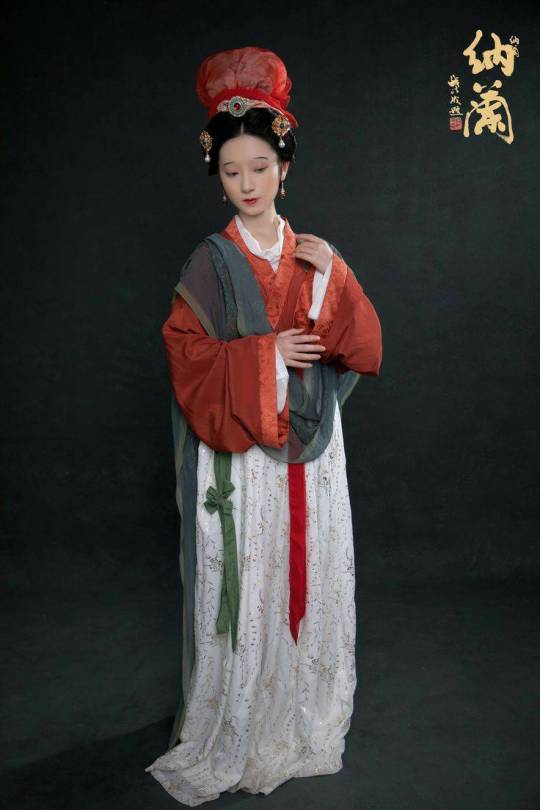
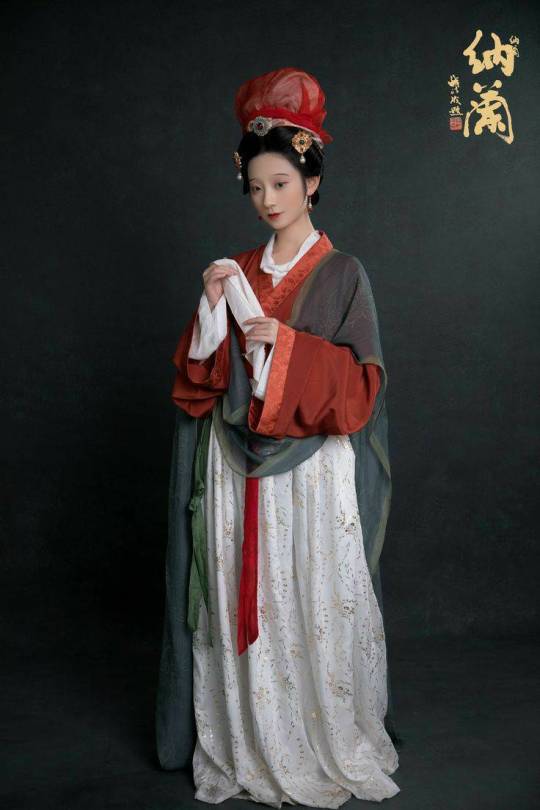
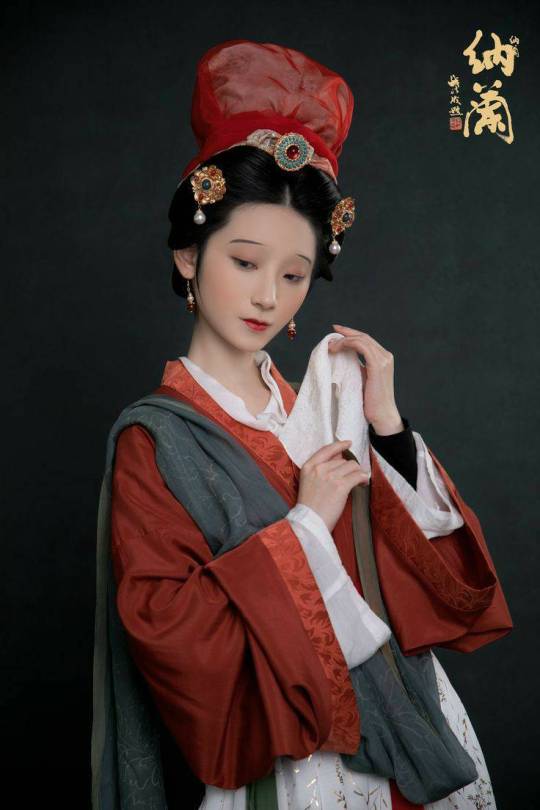
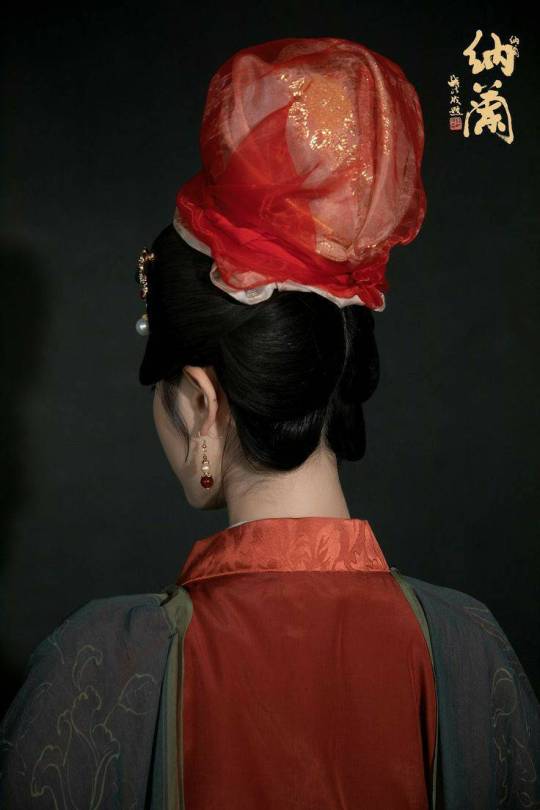
【Historical Reference Artifacts】:
China Song Dynasty Painted Sculpture from【Jin Temple】晋祠宋代彩塑
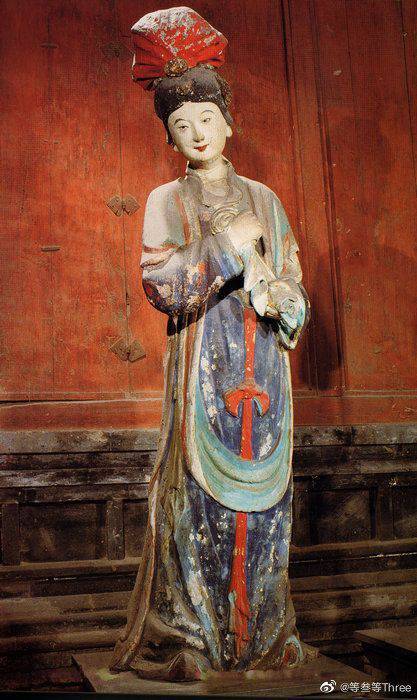
▶️【About Hairstyle“包髻/Bao Ji”】: It is one of the hairstyles of ancient Han women.
包髻/Bao Ji is a hairstyles that use rectangular headscarf to cover the hair. When worn, it is folded diagonally, wrapped from the front to the back, and then wrapped around the corner of the scarf to the front of the forehead to tie a knot.
As early as the Tang Dynasty(618-907 AD), there was a prototype of this hairstyle, and it became popular in the Song Dynasty.
Women in the Ming Dynasty(1368-1644 AD) liked to use black gauze to make this hairstyle and this kind of hairstyle survived until the last dynasty of China: the Qing Dynasty.
#chinese hanfu#Song Dynasty (960–1279 AD)#hanfu#hanfu accessories#hanfu_challenge#chinese traditional clothing#china#chinese#chinese history'#chinese fashion history#chinese historical hairstyle#chinese art#漢服#汉服#中華風#包髻/Bao Ji#Jin Temple
222 notes
·
View notes
Text
後李克強時代 習近平暗黑政治的來臨
中共官方宣布,前國務院總理李克強於10月27日因心臟病突發逝世。實際上,李克強的去世,死因離奇,過程蹊蹺。例如送到中醫院(上海中醫藥大學附屬曙光醫院)去急救!許多傳聞不免暗示,與其說李克強是「猝死」,不如說「促死」。至今為止,少有人相信官方的說法,甚至認定背後必有「習近平陰謀」的作祟。 「後李克強時代」:一個不抱希望的年代 隨著李克強的逝去,中國將進入後李克強時代。中國的溫和改革派路線宣告終結,除了剩下一個汪洋之外,「團派」已全數被殲滅。中共黨內已經沒有牽制習近平的聲音和力量,「中國共產黨」變成「中國一人黨」,叫「習黨」,中共應該改名,叫「習共」。習近平身邊既無可信之人,也無不可信之人。 在「後李克強時代」,中國韭菜百姓「改善生活」的願望破滅了,並將迎來一個「不抱希望的年代」。一個在李克強執政期間高速經濟增長的年代(平均7.5%)已經過去,未來中國百姓可能連「自求多福」的機會都已喪…
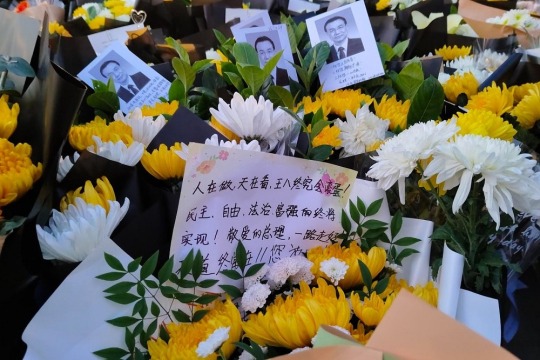
View On WordPress
0 notes
Text

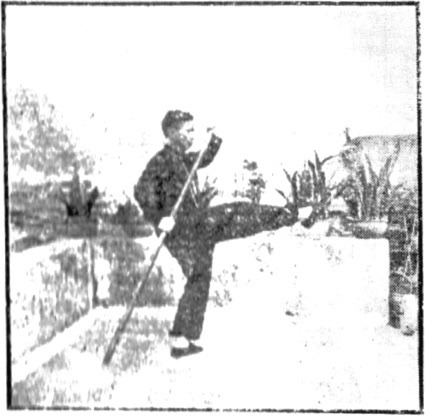




五郎八卦棍
FIFTH SON’S EIGHT-TRIGRAMS STAFF
黃漢勛
by Huang Hanxun [Wong Honfan]
[published by 香港鎮成書局 Zhencheng Bookstore of Hong Kong, 1955]
The techniques of Fifth Son’s Staff are simple, easy to learn and easy to apply. It is truly a means of training fundamental staff methods. Because the set is quite long, it is divided into two parts so that beginners can absorb it in a couple of shorter sections and thus more easily master its contents. Some general discussion of the origin of the set is supplied below in order for enthusiasts to be able to know something about the background to this staff art.
源流
ON THE ORIGIN OF THE ART
山後楊繼業(令公)一門忠義與勇武,據說連婢僕輩亦解武事,公生七子,除各有名號外並以大郎以至七郎為序。
歷史有名之「沙灘會」公率七子保宋帝會蕭天左於沙灘上,及兵敗公奮力保得帝離開沙灘返國,公以闖死於李陵碑下見志,當場死於皇事者有大郎、二郎、三郎等,四郎被俘,五郎出家於五台山為僧,七郎返國班取救兵而被害於潘仁美,僅六郎(延昭)生還耳!後六郎為報家報國仇掛帥征伐蕭氏,不幸又再次兵敗,被困五台山下,時五郎身雖出家但心仍繫念故國也。見大宋旗號帥字旗下大書一楊字,五郎(延德)知家族中人又興兵討伐外寇矣,但主帥方被困於山下,五郎身為出家人將於何處覓取武器呢!於是拔去閂門之短鐵桿跑下山崗奮力衝破敵陣,時六郎以為本國救兵已到因此精神大振,於是亦自內突出,六郎旣出,只見一和尚持短鐵棒到處追逐勇武絕倫,因此亦拍馬舞槍衝前助戰,蕭氏兵被逼暫時撤退,於是弟兄乃得陣上團叙,六郎勸五郎共返國以圖再次大舉,五郎曰:為兄已出家焉可復還俗,但蕭氏方勢大似未能求必勝,吾弟宜暫時撤兵囘國積極訓練兒郎以待他日之用,吾適間所用之棒法頗佳,吾弟何妨模倣之以為訓練士卒之用。六郎卒於戎馬倥偬中習之,後由六郎子宗保三次出兵率將頑敵推毀而雪兩敗之耻者,五郎之棒實著卓勛也,五郎棍之名因此歷千年尤膾炙人口者以此,且亦足證明吾說「棒脫胎槍法之源由」蓋五郎於卒然之間招棍作槍之使用法也,沿用五郎之名者亦至多,不論誰為眞傳或嫡傳總是皆以仰慕楊氏對棍法創設之紀念也。水滸中武松亦以用棒馳譽,卽今日之「行者棒」是也,棍法雖無悠久歷史,惟至今二十世紀年代,尤未被科學所淘汰者自有其可用之處,在練棍重點厥為圈、點、劈、軋、挑、撞、撒、殺。注意及之自當有成矣。
General Yang Jiye of Hebei [Shanxi] had a family that was loyal and valiant. It is said that even the girls were experts in military matters. He sired seven sons, each of which were nicknamed by their number: from First Son to Seventh Son.
There is a historical tale known as the “Gathering at Jinshatan”. At that place, Yang led his seven sons to protect the Song emperor against the forces of Xiao Tianzuo. When the imperial army had been defeated, the Yangs did all they could to ensure that the emperor was able to safely escape from the battlefield to return to the capital. Yang Jiye then killed himself by smashing his head against the monument stone to General Li Ling [in order to convince his sons to leave him there rather than be killed trying to rescue him now that he had been surrounded]. First Son, Second Son, and Third Son had already died on that battlefield in service to the emperor. Fourth Son was taken prisoner. Fifth Son (Yande) fled and became a monk at Mt. Wutai. Seventh Son was on his way home to gather reinforcements but was murdered on the way by Pan Renmei. Only Sixth Son (Yanzhao) returned alive, and he later dedicated himself to the cause of both home and homeland by leading an avenging army against Xiao. Unfortunately this army was also defeated, having been ambushed in the foothills of Mt. Wutai.
Although Fifth Son had become a monk, he still cared about his homeland. When he saw the banners of the Song Dynasty and that on the command banner was written “Yang”, he knew that someone in his family was leading a punitive expedition against the foreign invaders [i.e. the Khitans]. But that commander was being surrounded in the foothills, and so Fifth Son looked around for a weapon to use. Therefore he grabbed a short iron pole that was being used to bar a door, then ran out onto the hillside and put forth all his effort to smash away the enemy troops. He exhibited such powerful spirit that Sixth Son thought it was reinforcements sent from home. When Fifth Son suddenly emerged, Sixth Son came forward and saw only a monk holding a short iron staff chasing in all directions with a peerless courage. He then praised the “dancing spear” that had charged forward to his aid.
With Xiao’s army having been forced to make a retreat, the brothers then discussed the battle. Sixth Son urged Fifth Son to return home with him and make plans for future undertakings. Fifth Son said: “I’ve already become a monk. How can I go back to my old life? Although Xiao has a large force, there seems to be no way for him to win right now. You should withdraw your troops and go home, and then train them well to prepare them for the battles to come. The staff methods I used just now are rather effective. You might as well adopt them and use them to train your soldiers.”
Sixth Son eventually died in the midst of his chaotic military career. His son Zongbao later led armies three times to destroy enemy forces and avenge past defeats, in which Fifth Son’s staff methods performed meritorious service. The fame of the art has since been celebrated for a thousand years. To verify the saying that “the staff art is born from the spear art”, within the postures of Fifth Son’s Staff are contained many spear techniques. It is still called “Fifth Son’s Staff”, regardless of whether it is learned by someone within the family lineage or from outside it, for all admire and commemorate the staff art that Yang created.
8 notes
·
View notes
Text
蛇塚の宝
文政九年六月二十五日のことである。 小石川三百坂の路上に、蛇がたくさん集まって絡まり合い、団子状になっていた。 上から見ると、蛇は無秩序に重なっているわけではなかった。 中ほどは蛇が避けて空間ができており、塊全体で立てた桶のような具合になっている。 道行く人々が歩みを止めて見ていると、一人の少年が進み出た。 高橋千吉。十四歳。父は御三卿田安家小十人組の高橋百助である。 その千吉が言う。 「蛇がこんなふうに集まっているとき、その中には必ず宝があると聞く。そいつを探り当ててやろうじゃないか」 千吉は右袖をめくると蛇の塊に腕を突っ込んだ。肘が隠れるほど深い。 しばらく中を探っていた彼は、やおら腕を引き抜いた。 手には古銭が一枚。調べてみると、篆文の元祐通宝。宋代の銭である。 人々がそれを調べているうちに、蛇はばらばらにほどけ、それぞれどこかへ去っていった。 田舎ではこれを蛇塚と呼んで、よくあることだという。
(松浦静山『甲子夜話』巻之八十七 「蛇塚」)
5 notes
·
View notes
Text

【感想】岩波水滸21回
宋江と閻婆借の婚姻のくだり早かったな〜
仲人おばさんに屈する宋江…よっぽどしつこかったのか
張の三ちゃんw
遊び慣れてる男を連れていっちゃいけないよ
そもそも宋江もその気もないのに結婚するんじゃないよ…と現代人的に思う
押しに弱いんだろうな
唐牛二ナイス!と思ったのにおばちゃんに返り討ちに合うの残念すぎる
せっかくアイコンタクト(?)で通じ合えたのに…
ていうかおばちゃんがしつこすぎる
やはり宋江の脛をかじりたいのか
閻婆借と宋江の一夜のくだりが長すぎる…
まあ水滸本編で他にこういう夫婦の険悪なシーンみたいなのあんまない気がするから見どころではある
宋江さっさと帰っちゃえばいいのに〜と思うけどそれができないのが宋江ニキなんだな〜
書類袋忘れたの気がつくの意外と早いですね
というか薬屋のおじに毎回サービスしてもらってたんやなあ
閻婆借の一人称おばちゃんがきになる
自分の名前から取ってきて呼んでるのを日本語訳したらそうなっちゃったのか自分をおばちゃんと呼ぶ女の子の風習があったのかどっちや
宋江と閻婆借そもそも性格合わなすぎてほんと結婚するとこから間違えてるよなあ…
宋江もストレスが溜まりすぎると忘れ物するし人コロコロしちゃうんだな
2コンボで首落ちるほど思いっきりやっててすごいな
宋江の身代わりになってとばっちりで捕まえられる唐牛二かわいそすぎんか??
2 notes
·
View notes
Text
I was looking at Yun Jin’s and Furina’s TCG Chinese card captions
-
Yun Jin
“红毹婵娟,庄谐并举。”
(Hóng shū chánjuān, zhuāng xié bìngjǔ.)
“The (carpeted) stage’s beautiful actress, able to play both comic and tragic roles” (?)
…“Elegance on the carpeted stage, both comedic and tragic”?
Official English (alas): “Elegance on the stage, in decorous harmony.”
-
红毹 (hóng shū) —> (红 = red ) + 氍毹 (qú shū), type of patterned wool cloth/carpet, traditional Chinese theatre is often performed on carpets, thus 氍毹 or 红氍毹 often means “stage” (zdic)
Ohh!! I didn’t know that. Carpet on the stage…
“本义指古代西域进口的一种编织毯,后来引申为各种地毯挂毯床毯等,到了明朝,开始专指戏曲舞台。明朝是昆曲盛行的时代,演出时例必要在舞台铺上红地毯,是为“红氍毹”,渐渐地就成了戏曲舞台的代称。如此这个词儿基本不再用于口语,但是书面文章中仍然常见它的踪迹” (Guo Cui Jing Ju)—> basically, it originally referred to weaved carpet, then various carpets and tapestries. Until the Ming dynasty, where Kunqu opera gained popularity and there were always red carpets on the stage when performing, thus 红氍毹 became synonymous with theatric stage. (More literary than everyday usage though)
(Kind of similar to curtains associated with the western stage?)
婵娟 (chánjuān) —> literary term for a beautiful woman. Term appears in Su Shi’s 宋词 (Song ci, Song dynasty poetry) “水调歌头” (Shuǐ Diào Gē Tóu), “但愿人长久,千里共婵娟” but it likely refers to the moon in the line’s second half which talks about about sharing (the sight of?) a beautiful moon when miles apart
庄谐 (zhuāng xié) —> 庄 = serious; 谐 = humorous, lighthearted. Possibly comedy and tragedy?
并举 (bìngjǔ) —> develop simultaneously
-
Furina
“永世领唱,无尽圆舞。”
(Yǒngshì lǐngchàng, wújìn yuán wǔ.)
“Eternal lead singer, endless waltz”?
…“Perpetual prima donna, endless waltz”?
“Perpetual lead singer, endless waltz”?
Official English: “Perpetual muse of chansons and rondeaux.”
永世: “to/until [one’s] dying day” (Cambridge Dictionary)
“forever” (CollinsDictionary), eternal (Cambridge Dictionary)
领唱: the lead singer or soloist in a choir, or the act of leading a chorus (Baidu Baike)
but 领唱 also refers to cantor (in liturgical music and prayer, generally refers to the lead singer in a Jewish congregation but it also applies to Christian contexts too…? Feel free to correct me)
Oh, according to MyJewishLearning, “A cantor — hazzan (חזן) in Hebrew — is the person who chants worship services in the synagogue. Though the word is sometimes applied in a general way to anyone who leads services, it is more commonly used to denote someone who has completed professional musical training and been ordained as a cantor.”
Chinese term found in an English definition of cantor. (Cambridge Dictionary)
an English definition of cantor. (Merriam Webster)
Conversely, maybe 领唱 is HoYoverse’s way of saying “prima donna” which the Cambridge dictionary defines as “the most important female singer in an opera company” (a description fitting Furina)
prima donna is 首席女歌手 in Chinese (Cambridge) but its five characters wouldn’t fit the TCG’s eight-character restriction if the first part should only use four characters total…
chanson: “various eras of French song, from the monophonic chant of the Middle Ages to the polyphonic singing of the Renaissance. Modern chanson music connects nineteenth-century cabaret music in Paris to contemporary pop music” (MasterClass)
(In French “chanson” means song but as a borrowed word in English, the Chinese term for it is 香頌)(from Chinese article talking about French chanson on Gmw.cn)
rondeaux (plural), rondeau (singular): three-stanza poem of French origin, mainly octosyllabic, 10-15 lines (Poetry Foundation). (Chinese term: 回旋诗. From the online French-to Chinese dictionary frdic)
…where’s the 圆舞 part…? Why change the dance imagery to another poetic form when dance is one of Furina’s motifs?
圆舞曲: music written for a waltz and the dance itself
华尔兹: waltz, the music specifically. (Baidu Baike)
Meaning, the one in Furina’s card likely refers to a dance? (considering they took out the 曲 character which does mean “song”)
#yun Jin#kunqu#昆曲#原神#云堇#Furina#Furina de Fontaine#genshin Furina#genshin yun jin#genshin translations#genshin impact#dusk analysis#Genshin analysis#q
5 notes
·
View notes